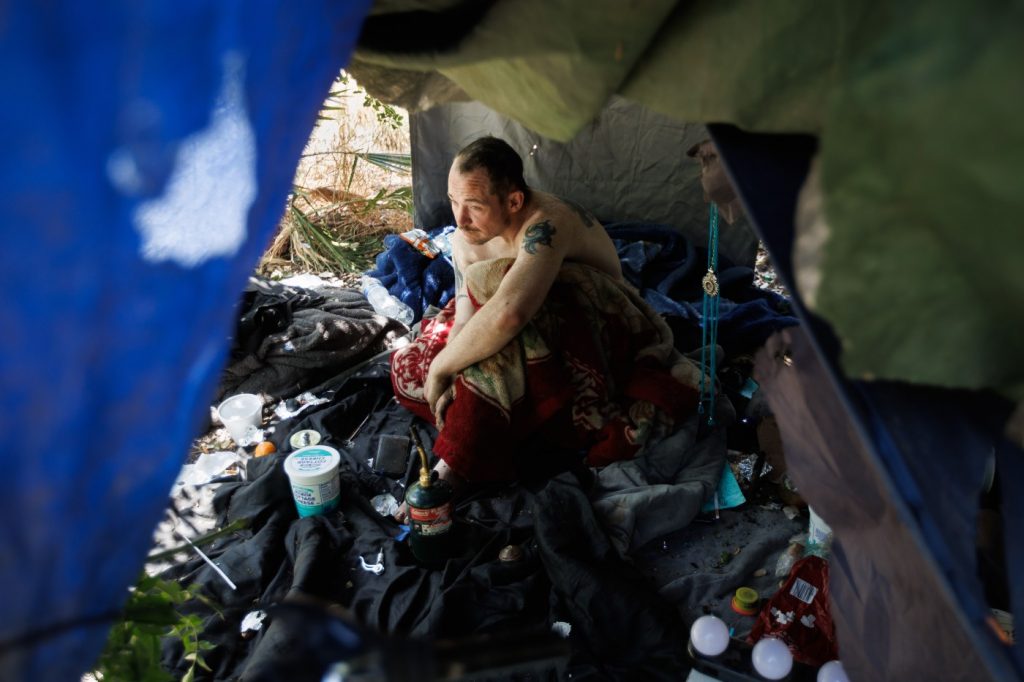At the direction of state regulators pushing San Jose to clean up its creeks and rivers, local officials are developing an ambitious plan to move about 500 homeless people living along its waterways to sanctioned encampment sites on public property across the city.
The City Council approved the basic outline of the plan last week as part of its new $5.3 billion budget. On Tuesday, the council will consider how to put it into action.
That includes whether to continue evaluating nine properties as potential locations for the managed camps, dubbed “safe sleeping sites” or “basic needs sites.” The sites, which would host around 100 to 150 people each, could provide individual tents, food, toilets, showers, laundry and case management services, with at least limited site security or monitoring.
During a tour of homeless camps along the Guadalupe River on Monday, Mayor Matt Mahan said the proposed sites will be critical to the city’s commitment to state water officials to drastically reduce the amount of trash and pollution flowing into its waterways over the next year.
“Until we get people into safe and managed locations, it’s nearly impossible to safely protect our waterways,” Mahan said.
There is not yet a timeline for when the sites could open, the mayor’s office said. But officials aim to approve at least one site by next month, according to a city report.
The locations the city is considering include an empty lot at 14020 Almaden Road, as well as 1157 East Taylor St., where squatters last year took over a city-owned home at the property. The sites are a mix of properties owned by San Jose, Santa Clara County the Santa Clara County Water District.
After the mayor’s tour ended Monday morning and local TV crews packed up their cameras, Joe Barnett sat cross-legged beneath a blue and green tarp tent, swaddled in a blanket and surrounded by half-empty cottage cheese containers and crumpled pieces of charred tin foil.
The 34-year-old Iraq War veteran said he’s been living along San Jose’s waterways for about the past six years, since returning to California from the East Coast. Barnett said he’d consider moving to a sanctioned encampment and hopes to eventually find housing, but added he doesn’t mind his spot near the river.
“I like living near the water, but I don’t want to go in it,” he said.
The state agency forcing the city to act is the San Francisco Bay Regional Water Quality Control Board, which has recently increased pressure on cities across the region to move encampments out of sensitive areas.
After three rejections, the water board recently approved the city’s plan to clean up its hundreds of miles of waterways. Mahan said the agency could fine the city tens of thousands of dollars daily if local officials fail to move enough people away from its creeks and rivers by June 2025.
The city estimates there could be around 1,000 homeless people living in areas the water board has identified for cleanup. In addition to setting up sanctioned encampments, the city is working to erect hundreds more tiny homes and is considering building dorm-style group shelters so people cleared from the waterways have a place to go.
In total, San Jose has an estimated 6,340 homeless residents, about 4,400 of whom live in encampments, vehicles, or other places not meant for habitation. The rest stay in shelters.
San Jose wouldn’t be the first city to try sanctioned encampments. The city has cited a managed camp in San Diego, which provides individual tents and basic security and sanitation, as a successful model.
“The status quo is a mess, it’s a disaster, we need to change it,” said Todd Langton, co-founder of the homeless advocacy group Agape Silicon Valley. “We need sanctioned encampments.”
In Sacramento, however, a managed camp that offers few services is under threat after the local district attorney labeled the site a public health hazard and sued the city to close it.
There’s also legal uncertainty about whether sanctioned encampments constitute the “adequate shelter” cities are expected to offer before clearing unmanaged camps. The U.S. Supreme Court, however, has signaled it may overturn that requirement in a decision set for this month.
Related Articles
Are tiny homes a cost-effective solution for homelessness? This Bay Area nonprofit thinks so
These Bay Area cities are now so expensive they’re considered ‘impossibly unaffordable’
California pushes insurers to cover more homes. Is your ZIP included?
San Mateo County approves $40 million for seven affordable housing projects
San Jose makes it legal to sell your ADU separately from your home
According to preliminary estimates, setting up the managed camps could cost between $18,000 and $40,000 per tent. For 500 tent spaces, that comes to around $9 million to $20 million. Operational costs could run between $22,000 and $33,000 per person annually. So far, the city has agreed to set aside $10 million for the sites over the next fiscal year.
While some advocates wanted to see that money go toward permanent affordable housing, Mahan argues the investment is necessary, not just to meet environmental requirements but also to ease human suffering on the street and ensure that neighbors feel safe visiting city parks and trails.
“We still need places for people to go,” he said. “It doesn’t do us any good just to move people down the creek.”


